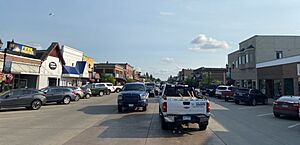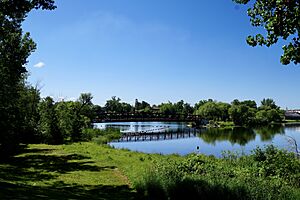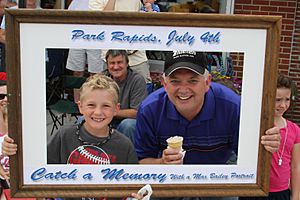Park Rapids, Minnesota facts for kids
Quick facts for kids
Park Rapids
|
|
|---|---|

Main Avenue in downtown Park Rapids
|
|

|
|
| Country | United States |
| State | Minnesota |
| County | Hubbard |
| Founded | 1882 |
| Incorporated | November 25, 1890 |
| Area | |
| • Total | 7.67 sq mi (19.85 km2) |
| • Land | 7.39 sq mi (19.14 km2) |
| • Water | 0.28 sq mi (0.72 km2) |
| Elevation | 1,440 ft (439 m) |
| Population
(2020)
|
|
| • Total | 4,142 |
| • Estimate
(2022)
|
4,269 |
| • Density | 560.56/sq mi (216.45/km2) |
| Time zone | UTC-6 (Central (CST)) |
| • Summer (DST) | UTC-5 (CDT) |
| ZIP code |
56470
|
| Area code(s) | 218 |
| FIPS code | 27-49768 |
| GNIS feature ID | 0649151 |
Park Rapids is a city in Hubbard County, Minnesota, United States. It is the main city, also called the county seat, of Hubbard County. The city is close to Itasca State Park, which is where the famous Mississippi River begins. It's also the start of the Heartland State Trail.
Park Rapids was founded in 1890. It is located near the rapids of the Fish Hook River. You can find the city along U.S. Highway 71 and Minnesota State Highway 34. In 2020, about 4,142 people lived there.
Contents
History of Park Rapids
The land where Park Rapids now stands was first home to Native American tribes. This included the Ojibwe (Chippewa) people. They still have a strong presence in the area today.
Park Rapids became a city in 1882. Frank C. Rice gave it its name. He was inspired by the park-like groves and open fields (prairies) next to the Fish Hook River rapids. These rapids now have a dam.
Park Rapids was built where open prairies met pine forests. This made it a key place for farmers and the lumber industry to get supplies. Early on, it was a busy spot. Trappers, the local Ojibwa community, and timber workers came here. They traded goods, shared news, and restocked their supplies.
Later, Park Rapids grew into a big center for logging. Many trails led north from the city. These trails were used by "tote teams" to carry goods. The main street in Park Rapids was made extra wide. This was to make room for the long, horse-drawn teams needed for the town's work.
City Infrastructure
Getting Around Park Rapids
Park Rapids and the area around Hubbard County have three main ways to get around.
South of the city center is the Park Rapids Municipal Airport. It is also known as Konshok Field. This airport is for general aviation, meaning smaller planes. The City of Park Rapids owns it.
For ground travel, there is the Hubbard County Heartland Express bus service. There is also a local taxi service. The closest airport for bigger planes is Bemidji Regional Airport. It has flights to Minneapolis–Saint Paul International Airport. That airport is about 200 miles away by car from Park Rapids.
Main Roads in Park Rapids
U.S. Highway 71 and Minnesota State Highway 34 are the two main roads that go through Park Rapids. In 2008, Highway 34 was made wider. It now has five lanes through the city.
Downtown Main Avenue has a special feature called "center parking." This means cars park in the middle of the street. Both Highway 71 and Main Street were rebuilt in the summer of 2009.
Geography of Park Rapids
Park Rapids covers an area of about 6.81 square miles (17.64 square kilometers). Most of this is land (6.59 sq mi or 17.07 sq km). A small part is water (0.22 sq mi or 0.57 sq km).
The Fish Hook River flows right through the city. Park Rapids is also surrounded by three lakes. These are Fish Hook Lake, Long Lake, and Potato Lake.
Climate and Weather
Park Rapids has a humid continental climate. This means it has warm summers. It also has long, cold, and snowy winters.
| Climate data for Park Rapids Municipal Airport, Minnesota (1991–2020 normals, extremes 1893–present) | |||||||||||||
|---|---|---|---|---|---|---|---|---|---|---|---|---|---|
| Month | Jan | Feb | Mar | Apr | May | Jun | Jul | Aug | Sep | Oct | Nov | Dec | Year |
| Record high °F (°C) | 58 (14) |
61 (16) |
80 (27) |
96 (36) |
99 (37) |
105 (41) |
107 (42) |
103 (39) |
99 (37) |
90 (32) |
73 (23) |
60 (16) |
107 (42) |
| Mean daily maximum °F (°C) | 18.1 (−7.7) |
23.8 (−4.6) |
36.9 (2.7) |
52.6 (11.4) |
66.5 (19.2) |
75.7 (24.3) |
80.2 (26.8) |
78.6 (25.9) |
69.2 (20.7) |
53.6 (12.0) |
36.4 (2.4) |
23.1 (−4.9) |
51.2 (10.7) |
| Daily mean °F (°C) | 7.6 (−13.6) |
12.3 (−10.9) |
26.3 (−3.2) |
41.0 (5.0) |
54.2 (12.3) |
64.2 (17.9) |
68.7 (20.4) |
66.7 (19.3) |
57.8 (14.3) |
43.6 (6.4) |
27.9 (−2.3) |
14.2 (−9.9) |
40.4 (4.7) |
| Mean daily minimum °F (°C) | −2.8 (−19.3) |
0.8 (−17.3) |
15.6 (−9.1) |
29.3 (−1.5) |
41.9 (5.5) |
52.8 (11.6) |
57.1 (13.9) |
54.8 (12.7) |
46.3 (7.9) |
33.5 (0.8) |
19.3 (−7.1) |
5.4 (−14.8) |
29.5 (−1.4) |
| Record low °F (°C) | −47 (−44) |
−51 (−46) |
−38 (−39) |
−8 (−22) |
14 (−10) |
27 (−3) |
35 (2) |
31 (−1) |
17 (−8) |
−3 (−19) |
−32 (−36) |
−46 (−43) |
−51 (−46) |
| Average precipitation inches (mm) | 0.43 (11) |
0.40 (10) |
1.00 (25) |
1.72 (44) |
3.09 (78) |
4.08 (104) |
3.93 (100) |
2.78 (71) |
2.70 (69) |
2.40 (61) |
0.81 (21) |
0.52 (13) |
23.86 (606) |
| Average precipitation days (≥ 0.01 in) | 5.6 | 4.7 | 6.6 | 7.8 | 11.7 | 12.4 | 11.7 | 10.1 | 10.0 | 9.9 | 6.1 | 6.8 | 103.4 |
| Source: NOAA | |||||||||||||
Population of Park Rapids
| Historical population | |||
|---|---|---|---|
| Census | Pop. | %± | |
| 1900 | 1,313 | — | |
| 1910 | 1,801 | 37.2% | |
| 1920 | 1,603 | −11.0% | |
| 1930 | 2,081 | 29.8% | |
| 1940 | 2,643 | 27.0% | |
| 1950 | 3,027 | 14.5% | |
| 1960 | 3,047 | 0.7% | |
| 1970 | 2,772 | −9.0% | |
| 1980 | 2,976 | 7.4% | |
| 1990 | 2,863 | −3.8% | |
| 2000 | 3,276 | 14.4% | |
| 2010 | 3,709 | 13.2% | |
| 2020 | 4,142 | 11.7% | |
| 2022 (est.) | 4,269 | 15.1% | |
| U.S. Decennial Census 2020 Census |
|||
In 2010, there were 3,709 people living in Park Rapids. There were 1,772 households. About 24.7% of these households had children under 18.
The average age in the city was 43.1 years old. About 22.1% of the people were under 18. And 24.9% were 65 years old or older. Slightly more than half of the residents (53.7%) were female.
Famous People from Park Rapids
Park Rapids is the hometown of two well-known authors: Will Weaver and Nathan Aaseng.
Will Weaver grew up on a farm. He studied at Saint Cloud State University, the University of Minnesota, and Stanford University. He worked as a farmer, a teacher, and a writer. Some of his most famous books are Striking Out, Farm Team, and Hard Ball. These stories show what it was like growing up on a farm in northern Minnesota. Weaver has won several awards for his writing. He now lives in Bemidji.
Nathan Aaseng is the son of a minister. He went to Luther College and Luther Seminary. He worked as a scientist, studying tiny living things (microbiologist-biochemist). He has written more than 130 books for young people. These books cover many different topics. Some of his works include Big Red, Wild Trek, and the "You Are the Coach" series.
Other notable people connected to Park Rapids include:
- John A. Ainley, Jr., a newspaper editor and lawmaker from Minnesota.
- Thomas Miller, a newspaper editor and lawmaker from Iowa, was born here.
- Esther Miriam Fieldman, a businesswoman and Minnesota state lawmaker, lived in Park Rapids.
- Aaron Pike, a four-time U.S. Paralympian, was born in Park Rapids. He moved away as a baby due to his father's military career. But he still comes back every summer and calls Park Rapids his hometown. Aaron competes in wheelchair racing and Nordic skiing.
Fun and Recreation
The Park Rapids area has over 70 lakes. Each lake offers great chances for fishing. Some important nearby lakes include Lake Itasca. This is where the Mississippi River begins! There are also many Crow Wing Lakes.
You can catch many types of fish in the area. These include largemouth, smallmouth, and rock bass. You might also find bullhead, crappie, northern pike, perch, sunfish, and walleye.
The Heartland State Trail starts in Park Rapids. This trail is one of the oldest "rail-to-trail" projects in the United States. It means an old railroad line was turned into a trail. The trail is 49 miles long. Different parts of the trail are open for horseback riding, hiking, snowmobiling, and biking.
Along the trail, you might see many animals. These include deer, coyotes, grey wolves, chipmunks, bobcats, bears, and bald eagles. You could also spot red foxes, raccoons, beavers, and muskrats.
Local Media
Park Rapids is home to De La Hunt Broadcasting, which is east of the city's downtown. There are three radio stations in Park Rapids:
- KPRM AM 870 (plays Talk shows and Classic Country music)
- KXKK FM 92.5 (plays Country music)
- KDKK FM 97.5 (plays Adult Standards music)
Park Rapids also gets five television stations:
- KAWE Ch. 9 PBS (from Bemidji)
- KVLY-TV Ch. 11 NBC (from Fargo)
- KCCW Ch. 12 CBS (from Walker)
- KVRR Ch. 15 FOX (from Fargo)
- KSAX Ch. 42 ABC (from Alexandria)
The local company that provides cable TV is Arvig Communication Systems.
Newspaper in Park Rapids
The Park Rapids Enterprise is the local newspaper. It is owned by the Forum Communications Company from Fargo, North Dakota. The newspaper is published twice a week.
Education in Park Rapids
Park Rapids Area High School is located at 401 Huntsinger Avenue. It serves students in grades 9 through 12. Century School, at 501 Helten Avenue, is for students in grades K (kindergarten) through 8.
Before, Park Rapids had separate buildings for younger students. Frank White Elementary and Park Rapids High School were in the same building. They served grades K-3 and 9-12. Grades 4-8 were in a different building.
The Century School was built in 2001. It was made to hold students from kindergarten through 8th grade. The old Frank White Elementary School was updated. Parts of it became part of the Park Rapids Area High School. Some of the Frank White classrooms are now used for preschool. The old Park Rapids Middle School building was sold. Parts of it are now apartments.
Images for kids
See also
 In Spanish: Park Rapids para niños
In Spanish: Park Rapids para niños










